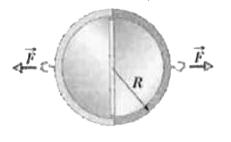In 1654 Otto von Guericke, inventor of the air pump, gave a demonstration before the noble-men of the Holy Roman Empire in which two teams of eight horses could not pull apart two evacuated brass hemispheres. (a) Assuming the hemispheres have (strong) thin walls, so that R in Fig. 14-63 may be considered both the inside and outside radius, show that the force →F required to pull apart the hemispheres has magnitude F=πR2Δp, where Δp is the difference between the pressures outside and inside the sphere,

(b) Taking R as 40 cm, the inside pressure as 0.10 atm, and the outside pressure as 1.00 atm, find the force magnitude the teams of horses would have had to exert to pull apart the hemispheres. (c) Explain why one team of horses could have proved the point just as well if the hemispheres were attached to a sturdy wall.
Text Solution
(b) 4.6×104 N (c) One team of horses could be used if one half of the sphere is attached to a sturdy wall . The force of the wall on the sphere would balance the force of the horses.
|
Topper's Solved these Questions
- FLUIDSBOOK - RESNICK AND HALLIDAYCHAPTER - FLUIDSEXERCISE - PRACTICE QUESTIONS (SINGLE CORRECT CHOICE TYPE)
48 Videos
- FLUIDSBOOK - RESNICK AND HALLIDAYCHAPTER - FLUIDSEXERCISE - PRACTICE QUESTIONS (More than One Correct Choice Type )
10 Videos
- FLUIDSBOOK - RESNICK AND HALLIDAYCHAPTER - FLUIDSEXERCISE - CHECKPOINT
8 Videos
- ELECTROMAGNETIC WAVES BOOK - RESNICK AND HALLIDAYCHAPTER - ELECTROMAGNETIC WAVES EXERCISE - PRACTICE QUESTIONS (Integer Type)
3 Videos
- FORCE AND MOTION - I BOOK - RESNICK AND HALLIDAYCHAPTER - FORCE AND MOTION - I EXERCISE - PRACTICE QUESTIONS (Integer Type)
3 Videos
Similar Questions
Knowledge Check
In Guericke’s experiment to show the effect of atmospheric pressure, two copper hemispheres were tightly fitted to each other to form a hollow sphere and the air from the sphere was pumped out to create vacuum inside. If the radius of each hemisphere is R and the atmospheric pressure is P, then the minimum force required (when the two hemispheres are pulled apart by the same force) to separate the hemispheres is
A2πR2PB4πR2PCπR2PDπR2P/2CSA of a hemisphere having radius 4 cm will be :
A32 πcm2B16 πcm2C64πcm2DNone of theseWhat divides the earth into two equal parts. The northern hemisphere and the southern hemisphere?
ATropic of CapricornBTropic of CancerCEquatorDArctic Circle
A cone and a hemisphere have equal bases and equal volumes. What is the ratio of the height of the cone to the radius of the hemisphere?
View SolutionWhich hemisphere is served more by the air transport? Why there is less development of it in the other hemisphere?
View SolutionThe surface area of a solid sphere is 5544cm2. It is cut into two hemispheres. Calculate the radius of the sphere and the total surface area of each hemisphere.
View SolutionWhen two spring balances joined at their free ends, are pulled apart, both show the same reading. Explain.
View SolutionBase area of hemisphere having base radius r cm will be :
View Solution
